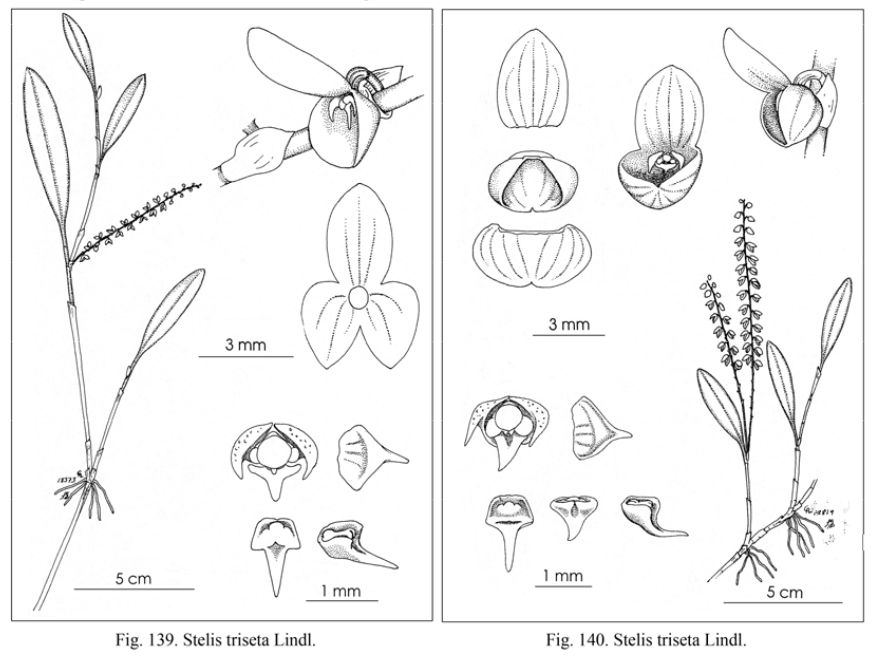

Stelis triseta Lindl. 1859 SECTION Humboldtia
TYPE Drawing by © Carl Luer and Selbyana 32(1,2): 119 Luer & Vasquez 2018


 LATE
LATE


Common Name The Three Bristle Stelis [referring to the aristate petals and lip]
Flower Size .24" [6 mm]
Found in Colombia and La Paz and Cochabamba departments of Bolivia at elevations around 1800 to 2900 meters as a mini-miniature to small sized, cool to cold growing, prolific or scandent epiphyte with erect to ascending, slender, prolific ramicauls enveloped by a tubular sheath from below the middle and 1 to 2 others at the base and carrying a single, apical, erect, coriaceous, narrowly elliptical, acute, cuneate below into the petiolate base leaf that blooms in the late spring and summer on an erect, arising from a node at the apex of the ramicaul, peduncle .4 to 2" [1 to 5 cm] long, rachis 1.2 to 4.8" [3 to 12 cm] long, erect, congested, distichous, mostly many, many flowered inflorescence with oblique, acute, as long as the ovary floral bracts and carrying flowers with green, yellow, rose to purple purple, glabrous sepals.
"Stelis triseta Lindl. is frequent in its wide distribution through the Andes. The flowers are similar to those of the also frequent and variable, but always caespitose, S. pardipes Rchb.f., from which it is easily distinguished by the prolific or scandent habit. Both species are characterized by small, bilabiate flowers with the tips of the sepals and petals setiform of variable lengths. In Luer (2009) collections of Stelis triseta were erroneously considered to be variations of the twice larger S. bicornis Lindl. Following Dunsterville & Garay (1965: 298–299), small variations of S. bicornis, or S. triseta, were erroneously considered to be S. biserrula Lindl. Stelis bisserula was poorly described, because the Jameson collection from Ecuador has only buds. A dissection of two buds hydrated in ammonia reveals the dorsal sepal to be five-veined, and the petals totally devoid of an apiculum. All specimens seen of the Ecuadorian S. triseta have a three-veined dorsal sepal, and petals with an apiculum. In Luer (2009) the description of S. biserrula applies to S. triseta. In Luer (2004), S. biserrula is illustrated and described as S. propagans Luer & Hirtz. Neither Stelis bicornis nor S. biserrula are known from Bolivia." Luer & Vasquez 2018
Synonyms
References W3 Tropicos, Kew Monocot list , IPNI ;
* Selbyana 32(1,2): 119 Luer & Vasquez 2018
Selbyana 32(1,2): 162 Luer & Vasquez 2018 Drawing fide;
Harvard Pap. Bot. 23: 175 Luer & Escobar 2018 drawing fide;
--------------------------------------------------------------------------------------------------------------------------
--------------------------------------------------------------------------------------------------------------------------